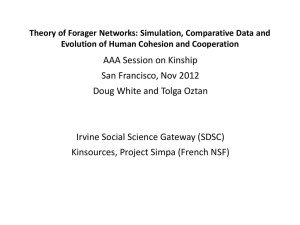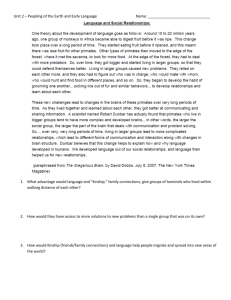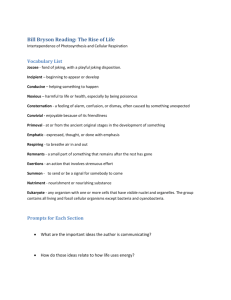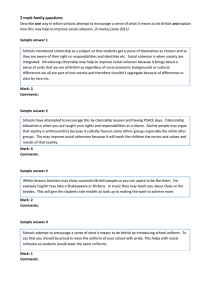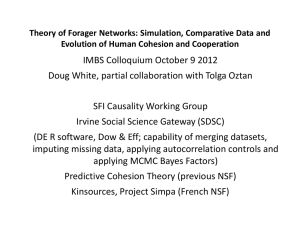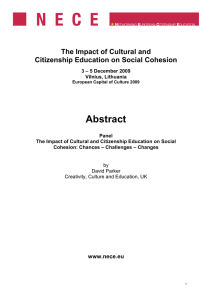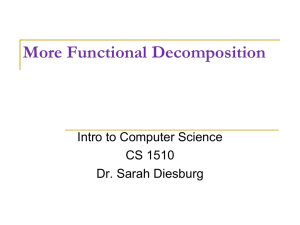AAA Session on Kinship San Francisco, Nov. 2012 24 slides
advertisement
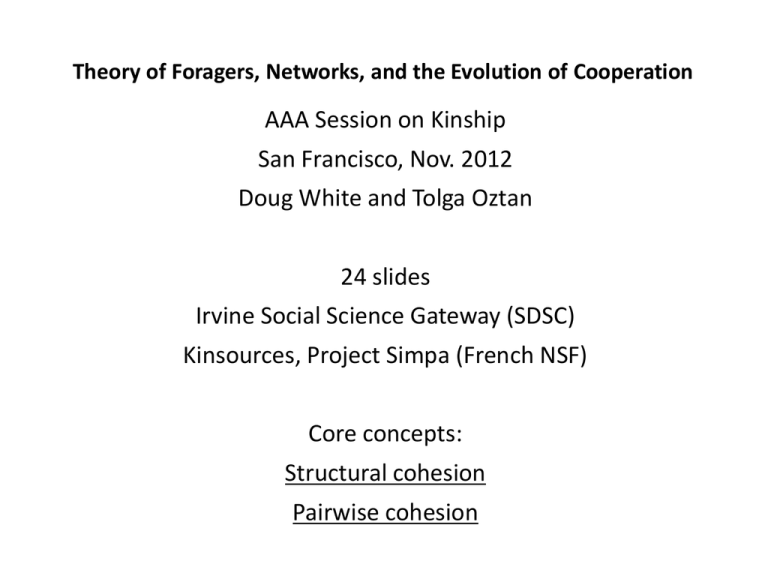
Theory of Foragers, Networks, and the Evolution of Cooperation AAA Session on Kinship San Francisco, Nov. 2012 Doug White and Tolga Oztan 24 slides Irvine Social Science Gateway (SDSC) Kinsources, Project Simpa (French NSF) Core concepts: Structural cohesion Pairwise cohesion Clues & Data (Binford 2001) We measure structural cohesion in kinship networks from actual genealogical data, looking at the variable of structural endogamy. This variable does not predict level of cooperativity for foragers. WHY Unless foragers have extensive marine resources & trade, which go hand in hand as in the Northwest Coast, their population density is usually light. At these light densities, and with 5-person average nuclear family size (outside Australia, 6.8), their kinship networks are often low in cohesion. e.g., Inuit societies, whose resource base stretches over large distances, have very low intra-community endogamy - spouses are often from distant communities. This provides little local marriage cohesion. Instead of marriage ties as a means of integration, in a maximal sample of 34 forager societies for which we have data, we find that kinship and affinal roles play a major role in creating both cohesion and cooperation. The idea here is pairwise cohesion. Table 1 combines Binford's forager population density data with stereotyped kinship roles coded by Murdock to show the importance of AFFINAL JOKING RELATIONS that are key to forager reproductive success because joking and license open pathways to sexuality among in-laws, i.e., pairwise cohesion. Parental in-law avoidances help indirectly to reduce conflicts of interest such as whether to marry a wife's sister. Table 1: below the packing threshold there are many more foragers with inlaw Joking and with more types of in-law joking ( !Kung upper left an outlier). Vertical red line = Packing density threshold at 9.1 people/kmsq at which there is no longer unoccupied space into which mobile hunter-gatherers could move (Binford 2001). Horizonal red line = crossover to 0 or singular joking pair Crossover 2x2 Fisher exact test p=.005 3 Table 2: population density with a packing threshold at 9.1 people/km2 is differentially related to Joking relations versus Avoidances (p=.008) Joking high at low density & decreases at higher densities p=.005, with Avoidance more uniform with density. All 34 societies have Joking or Avoidance, triangularly limited due to the limited number of kintypes. 4 Forager Cooperation: Binford 2001 Binford (p.469): “Below the packing threshold, hunter-gatherers are organized so that all participating individuals have maximal access to the vital resources that are accessible in their subsistence ranges. Participation in an economically integrated group means that all individuals endeavor to minimize the risk and maximize the return from cooperative labor that is directed toward obtaining the vital resources needed to sustain the group as a whole.” Sharing among near and distant kin “is very common among hunter-gatherer groups that have not approached the packing threshold, as is the practice—when necessary—of using tools and supplies that belong to other persons.” There are “kin conventions extending food procurement rights to distant kinsmen,” – including Joking cooperativity – rights that “tend to disappear” above the packing threshold. Cooperation is based on indirect reciprocity and easily emulated reputations. Children are taken by their family members to learn the skills of related kin. Differentiation is valued rather than competition. Cooperation is locally clustered, with pairwise chains. Its genesis is easily simulated in a distributed network with cooperative reinforcement based on reputation. 5 Simulations: What kinds of (kinship) networks do foragers have? © Helbing, Dirk. 2012. Social Self-Organization]. Springer Berlin. Chapter 14. Systemic Risks in Society and Economics] 285-299 Fig. 14.10 Establishment of cooperation (blue squares= cooperators, red = defectors/cheaters/free-riders). In a world with local interactions and local mobility (left) in comparison with the breakdown of cooperation (right) in a world with global interactions and global mobility (Helbing p140). The loss of solidarity results from a lack of neighborhood interactions, not from larger mobility. (see also Boorman and Levitt 1980 Chs. 2-5. The Genetics of Altruism. NY: Academic Press) For Dawkins and Nowak, Prisoner's Dilemma and Defection is the Universal Norm. 6 How Joking and Avoidance intermesh is illustrated by the Tenino trading network, with Joking relations as cooperative glue and Avoidances reducing conflict The Tenino are foraging traders at the gulf of the Columbia River. In the sample of 34, including Tenino, the six foragers groups with Br/Si Avoidance are predicted at p=.01 by “Fishing” as the regressor. The other 5 foragers are also central in trade networks. 7 These foragers were the major trading society at the mouth of the Columbia River. Tenino brothers-in-law (WiBr/SiHu) form chains of trading partners with special privileges; e.g., borrowing property and returning something of lesser value. Chains of brothers-in-law operated the trading routes. WiBr's daughters were also “Joking” relatives, could pass intimate information; one jokes with WiBr's sons. WiBrDa, Da of a trade partner WiBr, is “intimate but not sexually” with the FaSiHu trade partner. Between siblings-inlaw of opposite sex—BrWi & SiHu, “intimacy” occurs, even sexual intercourse. (Murdock 1965). Formal kin-type expectations for Joking relatives generally promote marriage and cooperation through affinal ties. Tenino Brother and Sister reinforce trade-link cooperation with an avoidance relation: they cannot even sit together or talk. WiBrWi is “like” a prohibited sister and also entails that Br/Si avoid each other. By avoiding WiBrWi there is no possibility of jealousy between WiBr and SiHu, the Tenino trade partners. WBW avoidance is more widespread than Br/Si avoidance. Br/Si → WiBrWi is an entailment!, showing that kinship cohesion is not always based on family tie “extensions” (Murdock, Shapiro etc); sibling is not an extension of affine. 8 Interpreting these clues The UNIVERSALITY of Joking and/or Avoidance in our 34-forager sample IS A GOOD INDICATOR THAT THESE STEREOTYPED KIN RELATIONSHIPS WERE PRESENT IN PROTOTYPICAL FORAGER SOCIETIES. THESE “REGULATORY KIN BEHAVIORS” MIGHT HAVE BEEN COMMON EVEN BEFORE THE ADVENT OF LANGUAGE. Joking links potential marriage partners and their siblings in an explicit means of cooperation within generations and often an expression of grandparental support rather than sexuality. The more extended networks of populations that surpass the packing density contain more non-kin, and Avoidances surpass Joking to provide indirect broadening of cooperation by means of conflict resolution between such potential marriage partners as siblings-in-law or same-generation links through chains of siblings-inlaw, as with the TENINO. Avoidances manage potential conflicts associated with Joking relations over sexual access. As management relations they have precisely interlocked structures, shown the next 'co-occurence and entailment' graphic. Four-Dimensional Dual Lattice isomorphic with the data: 100% fit Hu's Mo Hu's Fa Wi's Fa Wi's Mo Wife's BrSi Wife's Br femMoBr manFaSi Hu's Sister So Hu's Sister Kin Avoidances DRW(1995) “Kin avoidance entailments worldwide across kin types.” E.g., Br/Si entails → WiBrWi, which goes against the universal nuclear family “extentionist” theory (WiBrWi a superset over Br/Si). The entailments hold for foragers. Bottom to top co-occurrences are rare to frequent; top to bottom cases, frequent to rare. 10 Kinship Data as a DAG (Dir Asym Graph): Basic kin-net kinship networks: Nodes are parents, edges are gendered individuals THIS HELPS US LOOK AT COHESION THROUGH MARRIAGE ALLIANCE Here, married individuals are a single node but link up to separate parents Kin-net graphs constructed from standard genealogies or GED files, using PAJEK or a number of other programs. ` Femal e edge Marries her MBS FaFaSiDaSo Male edge This type of graph allows us to study cohesion in kinship networks. It has no k-components with k > 2, hierarchically embedded Coefficients of biological relatedness ri,j and pairwise cohesion ki,j can be coded in matrices or graphs with individuals as edges. no time? cut to 18 11 This is the Agta genealogy made by Oztan, 7+ generations from the 1940s to the present, 87.0 people/km2 (9 times the density threshold). The structurally cohesive marriages are shown in yellow. Binford classifies this as “a mutualist group that exchanged labor and forest products with their neighbors in return for agricultural products.” Young women often married non-Agta men who acquired rights in Agta land. Here, 100% of these (n=49) come from parents in the (yellow) bicomponent (p=.0007), unlike many agricultural societies where marginal women marry out. The “mutualist” marriages are at the center of the society in the assimilation period. DRW(1995) 12 Hypothesis: Among the !Kung (6.6 p/km2), are bicomponent (yellow) nodes more likely “cooperators”? (among questions being explored by Oztan: maybe no!) “Genealogical levels” (This and the five next slides show various ways of viewing structural cohesion) Just flip thru these quickly 13 Cohesive kinship networks are bicomponents with egalitarian structure (conducive to low bullying). Incoming-arrow to parents, outgoing from children, dotted line for daughter to parents, solid lines son to parents Rarely a tri- or higher k-component: Here again: !Kung san (Kalahari desert). Red lines cut the cohesiveness. “Layout (arrows to parents)” Degree centralities are also distributed: no time? 14 cut to 20 !Kung band-wise kinship p-graph solid lines male, dashed lines female, arrows point to parents “Camps” (Oztan) Research questions, e.g.: How do usufruct rights in resource clusters map onto kin ties, marriage and movement between groups, and band memberships? 15 This is the band-level pattern of !Kung Marriages (crosssided = Joking and Avoidances) “Pairs of Camps” !Kung Marriages have too little density of offspring to form many cohesive cycles 16 But !Kung Joking and Avoidances and local “sides” are ordered purely by the ego role-pattern “Egocentric” ego 17 Using graph theory cycles to measure cohesion between sides as a possible predictor of cooperation in a foraging society (!Kung – result is similar if females form the sides, men the links) “Sides” e – n + 1 = No. of cycles 128 – 118 + 1 = only 11! - 5/11 are not sided, tho this looks like twosided marriages the sides are random. Within generations it is joking relatives across-sides that generate pairwise cooperation. How Joking behaviors create cooperation between brothers-inlaw is further exemplified by the contrast with Pul Eliya farmers, with more children and population density. 18 Pul Eliyan Sidedness (P-graph): brothers in-law Joke and cooperate, siblings compete over inheritance of land and irrigation resources passed to son or daughter; gender ambiguity in sides. This is not random; 146edges -103nodes+1=44 cycles with 8 “errors” (p=.002). But this network is almost perfectly 2-sided for marriages of those with common ancestors (this can be seen visually in the 77 red lines within generations between sides). Can you spot the “wrong marriage”? Foragers are not dense enough to have this level of cohesive sidedness 19 structural cohesion as a measurement concept: Moody and White 2003 Menger’s 1927 theorem for a pair of isomorphic network measurements: (1) Maximal subnetwork with no less than a (min) k-node separator cut equals (2) Maximal k-cohesive subnetwork with a minimum number k of node-independent paths between any x, y pairs of nodes isomorphic with above (hard proof) Was a hard/slow algorithm (new work has made it a fast computation) Red line in the graph: node cut of 3 separating the graph into 2 parts (this graph is 3-cohesive) Recent studies show that low structural cohesion (2-3) in school-friendship networks are egalitarian; high structural cohesion (4-7) precipitates bullying. Our measure of kinship structure is low-cohesion; piling on of other linkages may become high-cohesion 20 Cohesion and behavior 3rd-4th grades Links= self reported friendships classes with egalitarian (low-k) classes with hierarchical (hi-k) cohesion have little bullying, cohesion have bullying, bullies liked, aggressors unpopular <--(no class size effect)--> victims unpopular All: aggression corr. with popularity but neg. corr. with social preference. All: victimization neg. corr. with both pop.&pref but not corr.21 with aggression UC Davis Faris & Felmlee bullying study: school-wide Links= self reported friendships 12th green 9th 11th yellow 8th blue scattered N ~ 6-700 more bullying within grades than between 10th orange 10th dark orange Better interpretation in the next slide where variance is examined http://vidi.cs.ucdavis.edu/projects/AggressionNetworks/ 22 Summary of a Network Theory for Evolution of Cooperation among Foragers. D.R. White & Tolga Oztan 2012. *Definitions are given in the discussion. (1) The perspective, evidence and simulation given here lead to a novel conception of human evolution as emerging from generalized cooperativity among archaic and later foragers, at variance with an intrinsic selfishness thought to imply universal competitive gaming, as Dawkins and Nowak suggested. (2) In general, for friendships, political & corporate alliances, growth of successful family groups, and, in kin groups--residence, inheritance and lower outmigration--, groups identified by structural cohesion* show consistent side effects not replicable by other measures. White et al. citations. (3) Forager evolution benefited from large brains, recognition of extensive biparental kinship networks, and of marriage within the group, i.e., .structural endogamy (technically, 2-cohesive or bi-connected* networks of kinship). But forager population density is often so low -- !Kung 6.6pl/km2, 21 Inuit average 2.4pl/km2 (Binford 2001)-- that stru-cohesion may be insignificant, with too few effective cycles. (4) Foragers at low densities have small tightly kin-integrated groups (family, band, composites of bands) with near-universal access to resources and use-rights mediated through kinship roles. Reputation for generosity is the basis for prestige and attempts at leadership domination are punished. Children acquire skills introduced by kin with diverse abilities and knowledge. Binford 2001. 23 (5) Stru-cohesion provides a basis for forager cooperation, augmented by pairwise k-cohesion* between ancestors with many children (White & Oztan), while stereotyped kinship roles (Murdock) such as Joking relations* can facilitate a direct basis for cooperation that is either group-extended, as between two subgroups marrying reciprocally, or as extended along chains, e.g., in trade partnership circuits. Within-generation cooperation is a common result of such role structures. (6) A second type of stereotyped pairwise roles that ameliorate potential kinship conflicts are those of Avoidance* of parents-in-law (which reduces conflict and loosens access to within-generation spouses) or Avoidance in WiBrWi and in Br/Si dyads (when siblings-in-law transitivity is at risk, e.g., in trader-circuits). (7) The great majority of foragers worldwide utilize these various mechanisms to facilitate cooperation, and have done so in the past. Below the forager packingdensity threshold (9.1/km2)*, Joking is most frequent, and declines with population density; while Avoidance is less frequent, and increases with population density. Both eventually decrease as complex societies develop with higher population densities. (8) As complex societies develop with high population density, local kinship networks may densify due to greater numbers of children, and as other nonkin relationships develop with high structural levels of cohesion, often marked by bullying others, success in defense of the group, and new conflict-avoidance mechanisms. 24 NOTES Agta population densities (Binford 2001: 118) are: Casiguran 87.0 p376, p405 Mutualists Fishing 40% Coastal Kagayan p405 Mutualists Fishing 15% Isabela 42.0 North Luzon 37.9 Casiguran 87.0 p376 “The Agta (Casiguran) (group 12), a mutualist group that exchanged labor and forest products with their neighbors in return for agricultural products, making them analogous to the Mbuti and Birhor as far as population density is concerned.” 1.0 LPACKINX Log10 of the Group 1 size (:18) Packing index. Using our structural endogamy (cohesion) method, we discover 40 “mutualist” marriages, where all the brides marrying outside have parents that are members of the Agta bicomponent, confirming Binford's description. 25 Dwight Read: I was looking at the preface of a book available online: "This book aims to address these questions and provide some ideas on how we may understand the principles that guide the development, stability and growth of complex social systems. The question which will be returned to is: what forces create and sustain an integrated whole? In other words, what exactly is ‘cohesion’, and why should we be concerned with its scientific investigation." The word cohesion caught my eye and I recall that this is something you have been concerned with. Right. The book is "The Making of Society" 2011 by Robert G. Hercock. He goes on to say: → "We are looking for deeper clues as to what makes society work, i.e. what processes foster cooperation, altruism and harmony in society. Some of the specific themes that will be addressed revolve around the impact of trust, consultation and cooperation, in the building of cohesive communities and organizations." Right. That's what Tolga and I have been looking at for clues about the evolution of human cooperation. With the absence of dominance hierarchies based on gender, compared to our closest relatives, humans evolved to recognize mating pairs within the band or community, to recognize fathers and father’s kin as well as the kin of mothers. This could form a basis for social cohesion among human foragers that differs from other primates. One hypothesis is that to the extent that differences in cohesion can be recognized and measured in forager societies, the more cohesive subgroups will also exhibit greater cooperation within the community. But wait...
